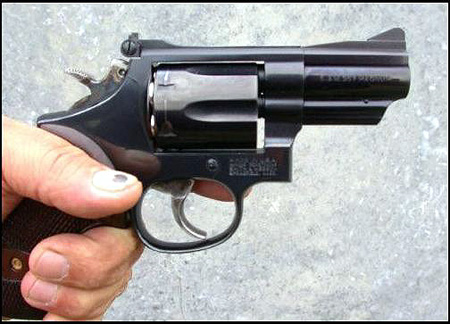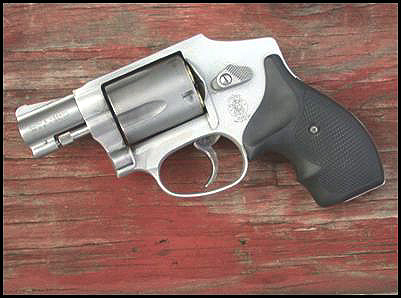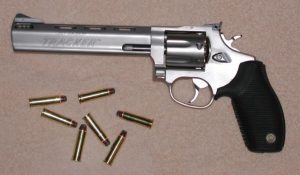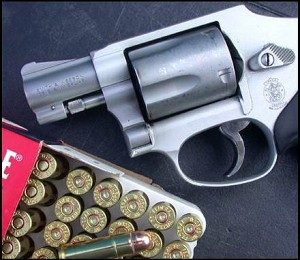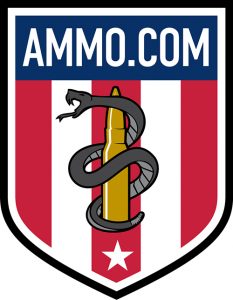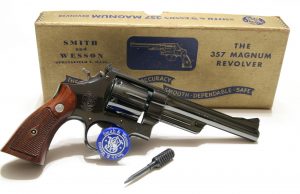
The .357 Magnum was developed in 1934 through the collaborative effort of Elmer Keith, Philip B. Sharpe, and D. B. Wesson of Smith & Wesson and Winchester. Although the effort was a collaboration, experts tend to give the lion’s share of the credit to Keith, an Idaho rancher, writer, and firearms enthusiast. Based on the S&W .38 Special, the .357 was intended to compare to Colt’s .38 Super Automatic. In the mid-1930s, the .38 Super Auto was the only American cartridge with a Muzzle Velocity over 1,000 FPS and the ability to penetrate automobile glass and vests that were often used by gangsters and bootleggers. The .357 was able to outperform most revolver cartridges on the market and quickly became the caliber of choice for law enforcement. In fact, D. B. Wesson wanted to use the .357 to reassert the company into being the premier law-enforcement armament provider. Wesson, along with the technical assistance of Phillip B. Sharpe, tweaked Keith’s original design only slightly to differ it from the .38. Sharpe was a member of the NRA’s technical division.
The introduction of .357 ammo heralded the beginning of the “Magnum Era.” The dual purpose cartridge is regarded by experts and used most often for target shooting, hunting, and self-defense.

Best .357 Magnum Self-Defense Ammo
Buffalo Bore: Tactical Short Barrel 158 Grain JHP
Buffalo Bore’s motto, “Strictly Big Bore – Strictly Business,” matches their attitude when it comes to manufacturing ammo for home defense. Tactical Short Barrel 158 Grain JHP works like clockwork in a snubnose. It shoots at 1,400 FPS muzzle velocity and offers 606 ft-lbs. muzzle energy. It uses a nickel-plated brass casing and Boxer primer.
Federal Ammunition: 158 Grain American Eagle .357 Magnum JHP
Federal’s American Eagle line is a well-respected name among firearms enthusiasts. The .357 line offers several rounds for self-defense. This 158 grain JHP bullet offers a muzzle velocity of 1,240 FPS and muzzle energy of 539 ft.-lbs. Note: In small weapons, this round has strong recoil.
Remington Ammunition: 110 Grain HTP SJHP
Remington’s HTP .357 Magnum SJHP is an excellent round for self-defense. The semi-jacketed hollow point, 110 grain bullet fires at a muzzle velocity of 1,295 FPS. New to the market, it is crafted with non-corrosive brass casing and premium Boxer primer. This cartridge offers excellent high terminal performance, delivering maximum accuracy, and instant-stopping power with proper shot placement.
Speer Gold Dot: Short Barrel 135 Grain JHP
Speer Gold Dot appears on most lists for being a top choice for shooters in every category. Their .357 Magnum Short Barrel 135 Grain JHP shoots slightly lower at a muzzle velocity of 990 FPS and muzzle energy of 294 ft.-lbs., which makes it an excellent choice for handguns and self-defense. It has a brass casing and is Boxer-primed.
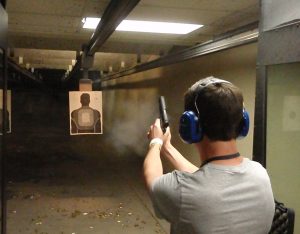
Best .357 Magnum Home Defense Ammo
CCI Ammunition: Blazer 158 Grain JHP
CCI is known for manufacturing excellent ammo using their patented CCI primers. Many self-defense experts rely on Blazer Brass for protection. This Blazer Brass JHP shoots at a muzzle velocity of 1,150 FPS, with a muzzle energy of 464 ft.-lbs.
Fiocchi Ammunition: 142 Grain FMJ-TC
Fiocchi is a well-established Italian munitions company that has a solid reputation for manufacturing reliable, high-quality products. This .357 Magnum 142 Grain full metal jacket round shoots at a muzzle velocity of 1,420 FPS and muzzle energy of 636 ft.-lbs. This new production ammunition is brass-cased, reloadable. non-corrosive, and Boxer-primed.
Hornady: Critical Defense 125 Grain FTX
Hornady manufactures a wide variety of superior ammunition and their .357 rounds are no different. Critical Defense is a top brand for Hornady. This 15 Gran FTX shoots 1,500 FPS muzzle velocity and has 824 ft-lbs. muzzle energy, using the company’s patented FlexTip bullet.
Sellier & Bellot: 158 Grain FMJ-FN
Since 1825, Sellier & Bellot has produced high-quality ammunition. Their experience shows in this 158 grain full metal jacket flat nose round. It shoots 889 FPS muzzle velocity and 278 ft-lbs. muzzle energy. The lower velocity drastically reduces recoil in short-barreled guns.
Best .357 Magnum Training Ammo
Magtech Ammunition: 158 Grain .357 Magnum SJSP
Magtech’s dedication to innovation and ability to produce quality ammo has given them a strong standing in the marketplace. The reloadable 158 grain, semi-jacketed soft point .357 Magnum bullet is manufactured with brass casing and Boxer-primed. It is known for accuracy with a Muzzle Velocity of 1,235 FPS and Muzzle Energy of 535 ft lbs. It is ideal for multi-use including self-defense, plinking, and range work.
Tula Ammunition: .357 Magnum 158 Grain FMJ
The Tula Cartridge Works was founded in Russia in 1880 and is one of the chief ammunition manufacturing plants in the world. Tula has gained a strong reputation for delivering an economical, rugged, and reliable product.
Tula’s .357 Magnum 158 Grain FMJ is at the top for the best .357 target shooting round and a good training round. Great for range training, it shoots at a Muzzle Velocity of 1,280 FPS. One downside might be that the steel casing doesn’t always make it easy to eject.
Fiocchi Ammunition: .357 Magnum 142 Grain FMJTC
Fiocchi Shooting Dynamics is a European company that has developed a stronghold in the marketplace by providing innovative, high quality products. This .357 Magnum 142 Grain round shoots at a Muzzle Velocity of 1,420 FPS. This new production ammunition is brass-cased, reloadable. non-corrosive, and Boxer-primed. Affordability, reliability, and high level of accuracy at long distances put it at the top for the best .357 ammo for the range.
CCI Ammunition: Blazer .357 158 Grain JHP
CCI is known for manufacturing some of the best .357 ammo in the marketplace. The aircraft-grade aluminum casing paired with a Speer bullet and CCI primers gives this round excellent accuracy on the range. Its hard metal coating atop the hollow point bullet helps to increase the ammo’s strength as well as thwart fouling in the barrel. It shoots at a Muzzle Velocity of 1,150 FPS, with a Muzzle Energy measuring 464 ft. lbs. In addition to range shooting, the CCI Blazer .357 bullet works equally well when hunting large game.
Best .357 Magnum Hunting Ammo
Small to Medium-Size Game
Barnes Bullets: 140 Grain VOR-TX
Barnes has been on the scene since 1880. The line was always a go-to for wildcats and African game hunters. Since 1974, Barnes honors that tradition and has ventured into innovative techniques. This 140 grain VOR-TX offers 1,265 FPS muzzle velocity and 498 ft-lbs. muzzle energy.
Federal Ammunition: Barnes Expander 140 Grain JHP
Federal makes good use of a Barnes bullet to make this 140 grain jacketed hollow point. It gives 1,400 FPS muzzle velocity and 609 ft-lbs. muzzle energy. The combination of Federal and Barnes makes winning ammo with controlled expansion.
Federal Ammunition: American Eagle 158 Grain JHP
Manufactured by Federal American Eagle, this 158 grain jacketed hollow point bullet allows for deep penetration along with great expansion capabilities. Touting a velocity of 1,240 FPS and Muzzle energy measuring 539 ft.-lbs., it is the best ammo for self-defense, hunting, and range training.
Fiocchi Ammunition: 142 Grain FMJ-TC
Fiocchi, a resilient brand based in Italy and the U.S. offers a 142 grain FMJ-TC for hunting small to medium-size game. It offers 1,420 FPS muzzle velocity and 636 ft-lbs. muzzle energy. The FMJ won’t over-penetrate or cause excessive damage to internal organs.
Hornady: Critical Defense 125 Grain FTX
Hornady’s Critical Defense ranks at the top for hunting and personal defense. The 125 grain FTX with FlexTip bullet is ideal for confronting targets. For those unsure of the right caliber for the job, Hornady offers a ballistics calculator to ensure you won’t over or under fire. This round offers 1,500 FPS muzzle velocity and 824 ft-lbs. muzzle energy.
Magtech Ammunition: 158 Grain SJSP
Magtech’s dedication to innovation and the ability to produce quality ammo has given them a strong standing in the marketplace. The reloadable 158 grain, semi-jacketed soft point .357 Magnum load is manufactured with brass casing and Boxer-primed. It is known for accuracy with a muzzle velocity of 1,235 FPS and muzzle energy of 535 ft lbs. It is ideal for multi-use including self-defense, plinking, and range work.
Speer: Gold Dot 158 Grain JHP
Speer Gold Dot remains on track with its 158 grain jacketed hollow point. This bonded round is excellent for small to medium-sized game as well as some bear and hogs. It works well in a handgun or rifle. The ammo offers 1,235 FPS muzzle velocity and 535 ft-lbs. muzzle energy.
Large Game Hunting
Buffalo Bore: Outdoorsman 180 Grain Flat Nose
Buffalo Bore is a go-to for Big Bore needs in the field. The Outdoorsman 180 Grain Flat Nose gives high power when and where it’s needed. The Flat Nose with high bullet weight ensures a better trajectory for the crucial shot. This round fires with 1,400 FPS muzzle velocity and 783 ft-lbs. muzzle energy.
Federal Ammunition: Power-Shok Ammunition 180 Grain SJHP
Federal’s focus on hydrostatic shock produces this Power-Shok 180 grain semi-jacketed hollow point for large game. The round allows for deep penetration along with controlled expansion to stop your prey in its tracks. capabilities. The round claims a muzzle velocity of 1,080 FPS and muzzle energy of 466 ft.-lbs.
Remington Ammunition: High Terminal Performance (HTP) 180 Grain SJHP
Some hunters live and die with Remington ammo. The company’s tried and true craftsmanship shows itself in the High Terminal Performance 180 Grain semi-jacketed hollow point. Accuracy and controlled expansion create hydrostatic shock in the largest game, leading to a humane kill. The round claims a velocity of 1,145 FPS and muzzle energy of 524 ft.-lbs.
Final Thoughts
Experts never agree on the ultimate all-around ammunition. The .357 Magnum ammo appears at the top of every list due to its stopping power, accuracy, availability, and reliability. The ammo carries the power necessary to dominate in any situation, whether in a snubnose, traditional revolver, or lever-action rifle. Where larger calibers bear the burden of possible over penetration, the .357 ammo is less likely to go through the target to cause collateral damage. The .375 Magnum ammunition can also be substituted with a .38+P for shots in close quarters, guns with a short barrel length or in situations where over penetration is a concern.

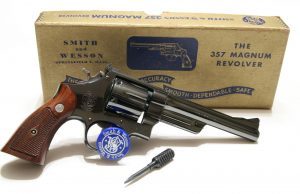
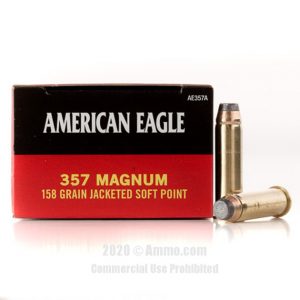 The Federal
The Federal 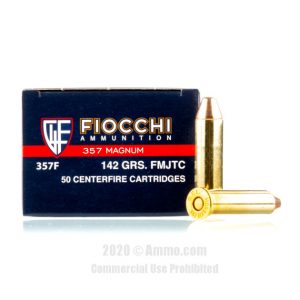 Fiocchi has a high standing in the ammo world as a company that manufactures quality ammo with consistent accuracy and reliability. The light bullet weight of this round helps to prevent over penetration upon impact.
Fiocchi has a high standing in the ammo world as a company that manufactures quality ammo with consistent accuracy and reliability. The light bullet weight of this round helps to prevent over penetration upon impact.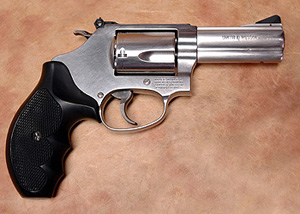
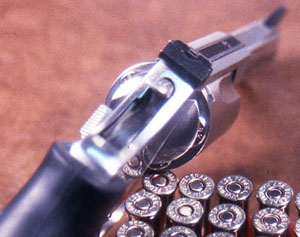 The 3 Model 60 has real sights which are adjustable, the ribbed top rail between the sights, the tapped and screwed-in black rear sight and rail along the top of the frame, and all surfaces are serrated to cut the glare. The front sight leaf is black and is pinned to the barrel. I can actually see these sights. The frame notch sights on the classic snubby really aren’t much use to me, although I have proven that I can use them if I really slow down and get my glaring blurs lined up right. The 3 barrel of the Model 60-15 allows the gun to have a 5 sight radius.
The 3 Model 60 has real sights which are adjustable, the ribbed top rail between the sights, the tapped and screwed-in black rear sight and rail along the top of the frame, and all surfaces are serrated to cut the glare. The front sight leaf is black and is pinned to the barrel. I can actually see these sights. The frame notch sights on the classic snubby really aren’t much use to me, although I have proven that I can use them if I really slow down and get my glaring blurs lined up right. The 3 barrel of the Model 60-15 allows the gun to have a 5 sight radius.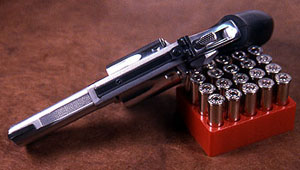 The 3 barrel and longer grip gives you a gun that performs better than the classic snubby. It has a better sight radius, better muzzle velocity, more reliable spent case ejection, and less punishment to your hands. For these benefits, you lose pocket carry. The 60-15 doesn’t disappear into a pocket like the classic snubby. I would imagine that it would be awkward in a jacket pocket as well.
The 3 barrel and longer grip gives you a gun that performs better than the classic snubby. It has a better sight radius, better muzzle velocity, more reliable spent case ejection, and less punishment to your hands. For these benefits, you lose pocket carry. The 60-15 doesn’t disappear into a pocket like the classic snubby. I would imagine that it would be awkward in a jacket pocket as well.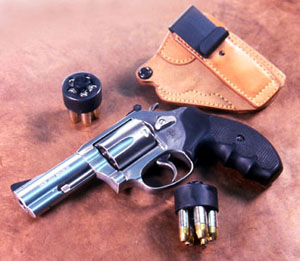 Aesthetics and Intangibles
Aesthetics and Intangibles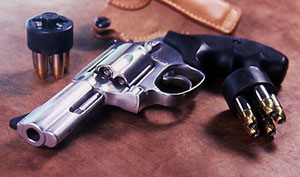 These guns still evoke the cowboy times. The cowboys carried six-shooters but often left the sixth chamber empty so they could put the hammer down without the fear of accidentally setting off a round. So why not build a five-round cylinder with a safe ignition system which would allow the gun to be slim and easier to conceal and carry? Its .357 Magnum chambering reflects the advances in ballistics of the 1930’s. The Model 60, being the first stainless steel revolver, carries the metallurgical advances of the last half of the Twentieth Century. With its key-operated safety lock, it carries the mark of the gun control battles of the late 90’s. Lots of history in these little guns.
These guns still evoke the cowboy times. The cowboys carried six-shooters but often left the sixth chamber empty so they could put the hammer down without the fear of accidentally setting off a round. So why not build a five-round cylinder with a safe ignition system which would allow the gun to be slim and easier to conceal and carry? Its .357 Magnum chambering reflects the advances in ballistics of the 1930’s. The Model 60, being the first stainless steel revolver, carries the metallurgical advances of the last half of the Twentieth Century. With its key-operated safety lock, it carries the mark of the gun control battles of the late 90’s. Lots of history in these little guns.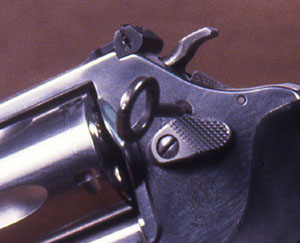 Interesting Lawyer-Friendly Stuff
Interesting Lawyer-Friendly Stuff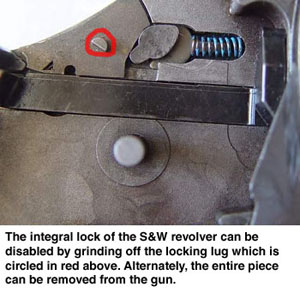 There has been some discussion of these safety locks engaging when they shouldn’t. In the January 2005 issue of American Handgunner, Massad Ayoob published an article about
There has been some discussion of these safety locks engaging when they shouldn’t. In the January 2005 issue of American Handgunner, Massad Ayoob published an article about 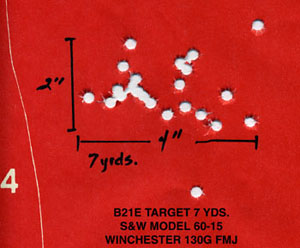 Range Report
Range Report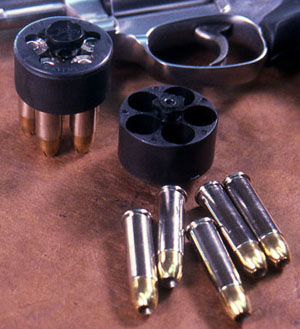 With a 5-shot J-frame, the issue of firepower always comes up, and if you want to carry these guns,
With a 5-shot J-frame, the issue of firepower always comes up, and if you want to carry these guns, 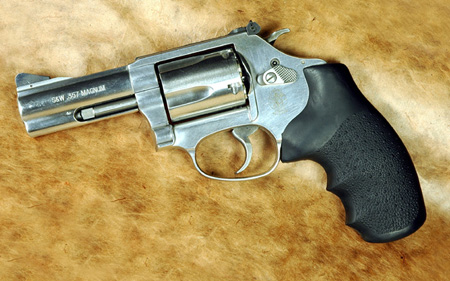
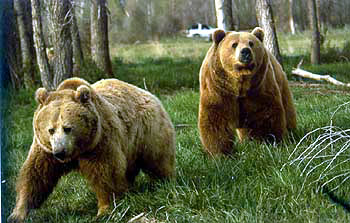 By Syd
By Syd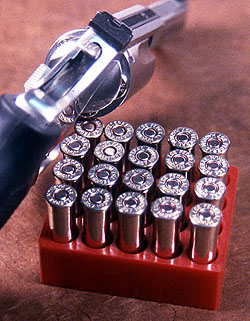
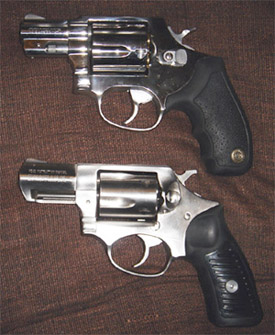 By Combat Controller
By Combat Controller